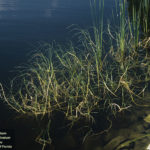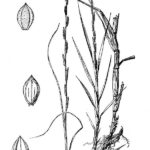Paspalidium geminatum
Illustration: USDA-NRCS PLANTS Database / Hitchcock, A.S. (rev. A. Chase). 1950. Manual of the grasses of the United States. USDA Miscellaneous Publication No. 200. Washington, DC.
What is Egyptian Panicgrass?
Physical Characteristics
Leaves:
- Grass-like
- Folded, flat, or rolling
- Up to 0.5 inches thick
- Up to 18 inches long
- Overlapping
- Covered in short hairs
Flowers:
- Spike-like
- 6-20 short branches
- End of branches covered in cluster of short hairs
- Rows of 2
Stem:
- Clustered
- Leaning or upright
- Bending at base
- Up to 5 feet tall
- Roots at nodes
Where Does it Grow?
USDA, NRCS. The PLANTS Database (http://plants.usda.gov). National Plant Data Team, Greensboro, NC 27401-4901 USA.
Egyptian panicgrass can be found in swamps, ponds, and lakes.
Pros and Cons of Egyptian Panicgrass
Submerged portions of all aquatic plants provide habitats for many micro and macro invertebrates. These invertebrates in turn are used as food by fish and other wildlife species (e.g. amphibians, reptiles, ducks, etc.). After aquatic plants die, their decomposition by bacteria and fungi provides food (called “detritus”) for many aquatic invertebrates.




